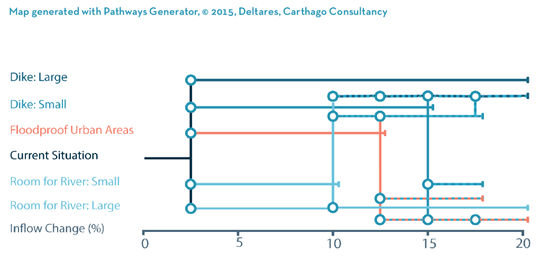Planning for an uncertain future: the development of adaptation pathways
By Charlotte van Strien
In order to cope with water problems, strategic plans have to be set up to prepare for the future. However, what this future will exactly look like is uncertain. Especially human behaviour and climate change induced by human activities is unpredictable. Therefore, it is needed to design flexible strategies that can be adapted to the way the future evolves.
One approach to generate these strategies is the Dynamic Adaptative Policy Pathways (DAPP) method. The approach allows for “planning under a wide variety of futures and can be adapted over time to unforeseen future conditions” (Haasnoot et al., 2013). This is done by creating a series of actions that respond to changing environmental and socioeconomic conditions. Such a series is called a pathway. Of course, decision makers desire to develop and select the best pathway, which would mean that the following questions have to be answered. What is the objective of the pathway? What is the best action to take? What is the best sequence of actions to follow? When is it best to take action? When should be prepared for a new action? What future(s) is the pathway designed for?

However, the answers to these questions may not be straightforward. Currently, expert judgement is thus used as no stepwise method exists to generate and select the best pathways, and datasets can be overwhelming. This moreover makes it hard for decision makers to explain the reasoning behind the selection of actions to the different stakeholders. Therefore, clear rules need to be set up to generate the most optimal dynamic adaptive pathways as possible. My research explores the possibilities for the use of multi-objective optimization techniques for the generation of these dynamic adaptive pathways. Two projects in Gabon and South Africa will be used as case studies.